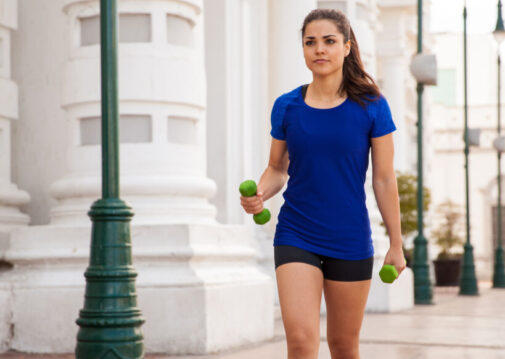Should you add weights to your walk?

The average adult naturally loses a few pounds of muscle each decade if they don’t regularly perform strength training exercises. This can make daily activities, such as cleaning, shopping and dressing to become a hurdle and eventually a task you won’t be able to perform.
It’s recommended each adult performs at least two days of muscle strengthening exercises each week, according to the Centers for Disease Control and Prevention. You may initially think of bench press weights, but it may be easier for you to sneak it into your upcoming walk by adding some weights instead.
Weighted walking can be done a few ways:
Ankle and/or wrist weights
Choosing ankle and/or wrists weights that are 5 or less pounds can not only increase the strength in your calf muscles, quadriceps and hip flexors, but also strengthen your core muscles.
Although, be cautious as this extra weight can put more pressure on your knees, hips and wrists. This can cause or worsen joint issues, such as arthritis. It can even exacerbate the body’s symmetry and lead to injuries.
Hand weights
If ankle or wrists weights are too much for you, you can opt for hand weights. They are easier to add to your daily walking routine, but still increase calorie burn just like ankle and wrists weights by adding resistance to your natural arm swing.
However, the added resistance can cause injuries since it can put stress on your bicep and elbow. This is due to the flexed alignment when holding the dumbbells during your walk.
Weighted vest
Weighted vests evenly distribute weight around your entire core, which puts less stress on the joints. This option improves your endurance, stamina and bone health. Instead of choosing a 20- or 25-pound vest, opt for something that is within 5% to 10% of your body weight to avoid injury.
Weighted backpack
Wearing a weighted backpack can improve your posture and strengthen your back and core muscles. People who have neck and/or back issues should cautiously approach this option. Since it distributes weight solely on your back, slowly add weight to avoid unnecessary back strain. This strain can be caused by you significantly leaning forward due to the weight of the backpack which can interfere with the body’s natural alignment.
Most importantly, it’s all about finding a sustainable weighted walking option you enjoy and will continually do over time.
Katarzyna Charytoniuk is a registered nurse at Advocate Health Care.
Are you having back problems? Take a free online quiz to learn more.
















